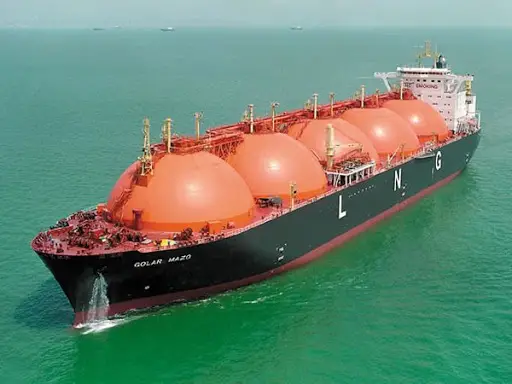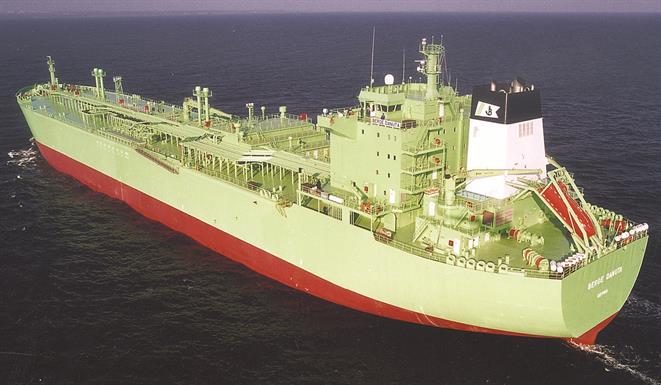The fleet of ships for the transportation of gas today comprises more than 950 units with an average ship age of 14 years.
The origin of gas carriers dates back only a mere 45 years, and even less about the most sophisticated ships, liquid natural gases carriers, since they account for only 35 years of existence.
Page Contents
How much is the total capacity of gas carrier industry?
The total capacity of this fleet averages 19,000,000 m3
This capacity is shared between the transportation of gases for the supply of energy for industrial or domestic ends, and the transportation of gases for chemical purposes.
The gas transportation fleet is made up of all sorts of different ships, from the small Liquefied Petroleum Gas Carriers with a few hundred cubic metres in the 1950s to the actual 138,000 m3 Liquefied Natural Gas Carriers.
Other gases are transported, and as a consequence, there are also different types of ships.
Division of gases considering the final use
The gases can informally be divided into the three following categories depending on their final uses:
- 1st category: these gases are used for energy purposes. That is the case for petroleum gases (propane, butane, a mixture of both) and natural gases (mixture with up to 80% of methane).
- 2nd category: these gases are used in the chemical industry. That is the case for ethylene, vinyl chloride, propylene, etc.
- 3rd category: these gases are used as a raw material for the making of agricultural fertiliser. The main gas used is ammonia.
When considering the carriage by sea of a specific gas, it is necessary to look at the various properties likely to influence the design and safety aspects such as:
- – physical properties and (namely) thermodynamical properties
- – flammability
- – toxicity
- – reactivity
PHYSICAL PROPERTIES of gas and definitions
Gas is a product with a vapour pressure exceeding 2.8 bar absolute at a temperature of 37.8″C.
Boiling temperature is a temperature at which a liquid boils at a specific pressure. It is usually given at the atmospheric pressure.
Critical temperature is the temperature above which a specific gas can no longer be liquefied.
MARVS is the maximum allowable relief valve setting of a cargo tank.
Primary barrier is the inner element designed to contain the cargo when the cargo containment system includes two barriers.
Secondary barrier is the liquid-resisting outer element of a cargo containment system designed to afford temporary containment of any envisaged leakage of liquid cargo through the primary bamer and to prevent the lowering of the temperature of the ship’s structure to an unsafe level.
THE DIFFERENT TYPES OF SHIPS
Liquefied Petroleum Gas Carriers

The Liquefied Petroleum Gas Carriers are built for the transportation of petroleum gases.
But they often carry some other gases of the 2nd and the 3rd category, such as ammonia, propylene and vinyl chloride, provided that a few additional changes are made.
We have seen that petroleum gases can be liquefied through simple compression and under moderate pressure at ambient temperature. For example, propane can be liquefied at 45°C at an average pressure of 16 bars.
But it is also possible to carry some gases at their boiling temperature and at the atmospheric pressure. For example, propane can be carried at about -45″C, butane at -10°C.
Considering the temperature and the pressure needed, the Liquefied Petroleum Gas Carriers can be divided into three categories:
- full pressure type
- semi-refrigerated type
- fully refrigerated type
The choice between these three, types of ships is based on economical considerations and on-shore storage techniques
The full pressure type
This technique is usual for small size ships (less than 4,000 m3 of cargo spaces).
The the pressure is up to 18 bars.
The tanks are independent, of type C, and can be submitted to Vacuum (about 80%).
The requirements of pressure structure resistivity are imposed to realise the best compromise between cylinders, spheres and cones to obtain large cargo capacity at a low price.
As a rule, tanks are now horizontal and sometimes bi-lobed.
The 80% vacuum resistivity imposes some reinforcements with stiffeners.
The tanks also have to be kept away from excessive stresses on the support parts and from the bending effect. Elastic connections between supports and tank shell are necessary.
The semi-refrigerated type
This technique is for cargo spaces around 7,500 m3, the largest space being 30,200 m3.
The pressure is either around 6 to 8 bars or the atmospheric pressure. The tanks are of C type and independent.
Two different ways of cargo transportation can be used:
– full re-liquefaction at atmospheric pressure
– partial cooling at a temperature lower than the ambient temperature.
As an example: 6 to 8 bars pressure allows butane transportation without any refrigerating system and propane transportation with reduced use of a refrigerating system.
The cargo tank problems are in some ways similar to those of “full pressure” type.
No secondary barriers are required.
The parts of the hull submitted to low temperature are near to the supports.
Tank contractions may occur. Therefore, insulation is required. Generally, plastic foam is used together with a steel sheet for a vapour barrier. If the transportation temperature is above zero, its thickness is dictated by the need to avoid condensation on insulation.
The refrigeration is directly made with a compressor, where tanks play the evaporator role.
Another technique which is not very commonly used consists of coils inside the tanks which serve as evaporators.
The fully refrigerated type

This technique is used for cargo tanks between 10,000 m3 and 100,000 m3.
The temperature is always above -50°C; this limits the importance of the contractions and simplifies the material selection.
The tanks are self-supported type A tanks with a prismatic shape fitted with a secondary barrier.
Double hull can be considered as the secondary barrier provided that suitable steel is used.
In addition, gas detectors have to be fitted in this space, in order to signal any tank leak.
Liquefied Natural Gas Carriers
For liquefied natural gases, the critical temperature is around -80°C with a very high critical pressure.
Thus it would be challenging to design a structure which would resist this very high pressure.
Liquefied natural gases can be transported today without any refrigeration.
The cargo naturally evaporates under the thermal flow.
This cargo is used as fuel for boilers or for the main engine. The main problems concern tanks, due to the low temperature (-160°C).
For example, in the case of membrane tanks, the tanks and ship structure need insulation between them with a “secondary barrier” inside the insulation.
The spaces between tanks and secondary barriers have to be inerted. Because of the low temperature, the inert gas used is nitrogen.
The tank has to be able to contract freely when going from ambient temperature down to the temperature of the gas.
Forces are reported on the ship’s structure utilizing supports and keys which are to be designed to allow contractions while avoiding thermal bridges.
Between the tank and the ship’s structure, and insulation is limiting the range of temperature through the walls.
The secondary barrier enables provisional recovering of cargo leakage in the space between tank and insulation barrier.
